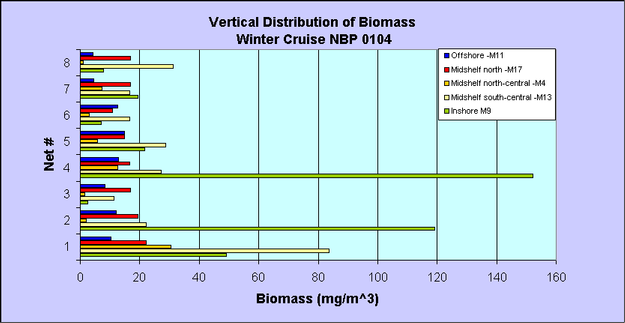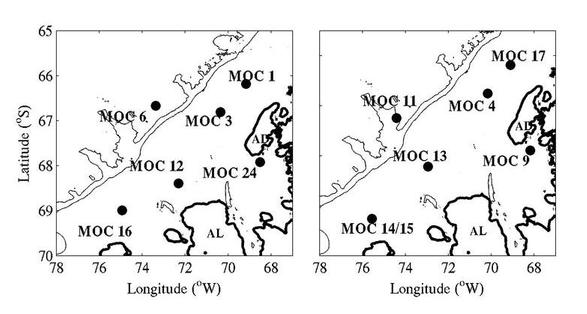The MOCNESS-1 plankton sampler has nine rectangular nets (1m x 1.4 m) with a mesh size of 0.333 mm, which are opened and closed sequentially by commands through conducting cable from the surface (Wiebe et al., 1976).
Biomass (wet weight) and abundance were determined principally by silhouette digitization of taxa lengths and conversion to equivalent wet weights according to the equations and methods adapted from Davis and Wiebe (1985) and Wiebe et al. (2004). New formulas were calculated for Southern Ocean krill because the length-weight relationship (Wet Weight = 0.0054*Length3.214) differed from that of the North Atlantic euphausiids (Wet Weight = 0.0138*Length3.071; Davis and Wiebe, 1985).
MOCNESS Sample Analysis (from Ashjian et al., 2004)
Silhouette photographs first were obtained from each sample; this photograph then was scanned with an Epson Expression 1600 scanner at 1200 dpi to produce a Tagged Image File Format (TIF) image. Identification and measurement of organisms from the tiff image were accomplished manually using the specialized MATLAB (Mathworks, Inc.) routine, the WHOI Silhouette DIGITIZER (v 1.0) (Little and Copley, 2003). A scanned photographic image of an aliquot of a sample was displayed with a superimposed reference grid on the computer screen. The operator identified each organism to taxonomic and/or size category by selecting the appropriate category button. Organism lengths (both straight and curved) then were measured by the operator using the cursor on the computer screen. Although the nominal resolution of the measurement is 0.02 mm, in practice the resolution was ~0.05 mm. In instances where there were too many organisms of a given type to justify measuring every individual organism, the DIGITIZER routine generated a list of randomly located cells to systematically sub-sample the overall image. Each organism's biomass was calculated automatically from its length measurement using the appropriate length-weight relationship.
This is a graph of the vertical distribution of biomass from the Winter 2001 Cruise, NBP0103. Net 8 is closest to the surface and net 1 is deepest:

This is a graph of the vertical distribution of biomass from the Winter 2001 Cruise, NBP0104:


Figure 1. Map of Tow locations, Fall and Winter, 2001
Table 1. Summary of locations, times, and depths for the twelve net tows.
(Note: Winter tows 14 and 15 were considered one tow because when ice and malfunction led to no data in the top three nets of Tow 14, MOC Tow 15 was fished in the upper 90 meters to compensate.)
| Cruise |
Region |
Tow
Number |
Date |
Time
(Local) |
Light* |
Lat(S) |
Lon(W) |
Tow Depth(m) |
Bottom Depth(m) |
Ice Cover
(tenths) |
| Fall |
Offshore |
6 |
05/04/01 |
1332 |
D |
66 40.17 |
73 22.08 |
0-1001 |
3650 |
0 |
| |
Midshelf 1 |
1 |
04/30/01 |
2050 |
N |
66 10.80 |
69 10.47 |
0-306 |
360 |
0 |
| |
Midshelf 2 |
3 |
05/02/01 |
0320 |
N |
66 48.53 |
70 21.42 |
0-348 |
600 |
0 |
| |
Midshelf 3 |
12 |
05/13/01 |
1830 |
N |
68 23.62 |
72 18.44 |
0-356 |
400 |
0 |
| |
Midshelf 4 |
16 |
05/18/01 |
0854 |
N |
68 59.43 |
74 55.77 |
0-340 |
350 |
0 |
| |
Marguerite Bay |
24 |
05/29/01 |
0300 |
N |
67 55.33 |
68 30.69 |
0-602 |
690 |
0 |
| Winter |
Offshore |
11 |
08/11/01 |
0918 |
T |
67 14.69 |
74 25.27 |
0-989 |
2917 |
10 |
| |
Midshelf 1 |
17 |
08/26/01 |
0306 |
N |
66 11.13 |
69 06.21 |
7-305 |
346 |
6 |
| |
Midshelf 2 |
4 |
07/31/01 |
0949 |
D |
66 45.18 |
70 09.64 |
11-413 |
501 |
8 |
| |
Midshelf 3 |
13 |
08/17/01 |
2117 |
N |
68 13.21 |
72 56.53 |
0-230 |
325 |
10 |
| |
Midshelf 4 |
14 |
08/21/01 |
1136 |
D |
69 15.55 |
75 34.00 |
20-290 |
~340 |
7 |
| |
|
15 |
08/22/01 |
0327 |
N |
69 12.30 |
75 43.90 |
0-91 |
~350 |
9 |
| |
Marguerite Bay |
9 |
08/08/01 |
0215 |
N |
67 53.74 |
68 10.82 |
0-488 |
600+ |
9 |
*Light conditions are designated as:
"D" = day, sunlight present;
"N" = night, darkness;
"T" = twilight

 ©2024 Biological and Chemical Oceanography Data Management Office.
©2024 Biological and Chemical Oceanography Data Management Office.
